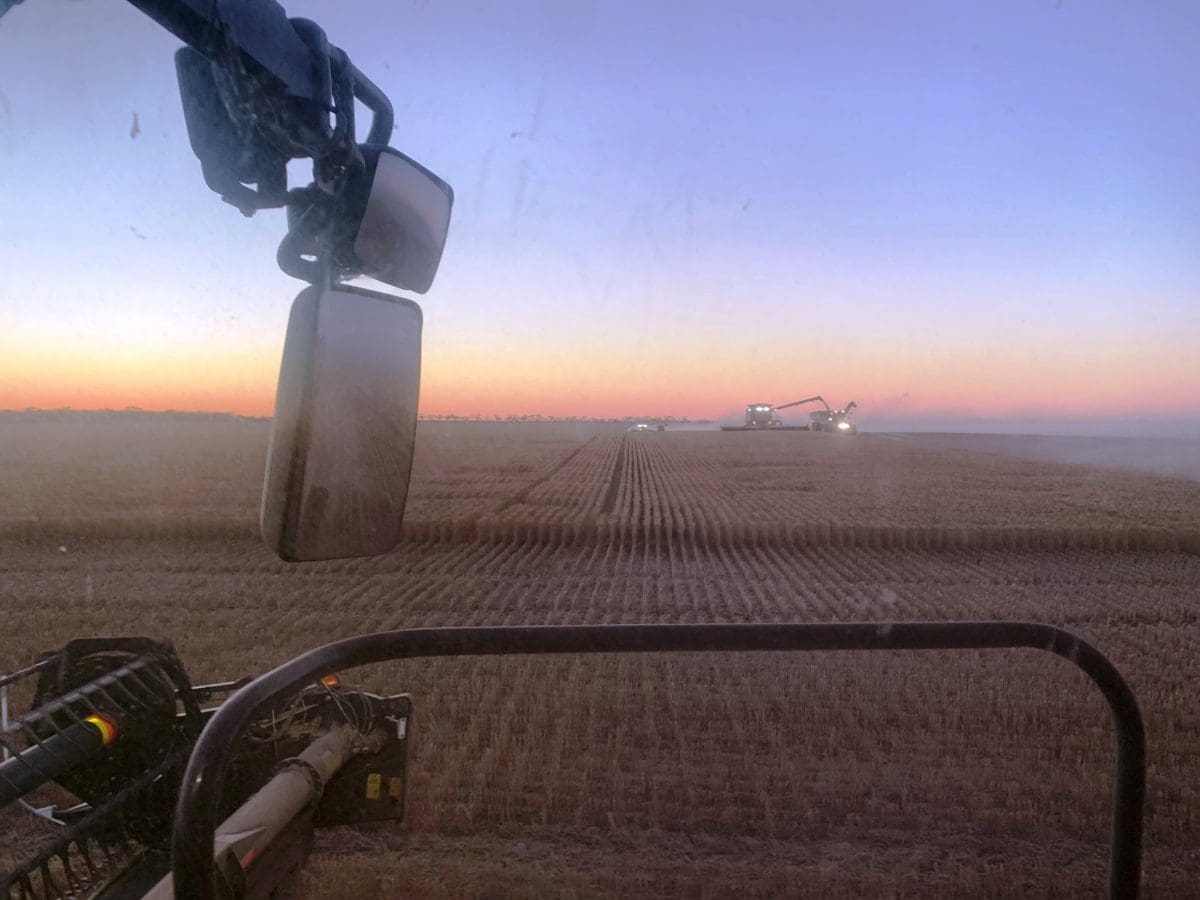
Harvesting wheat near Beulah in the southern Mallee. Photo: Dale Hinkley
A WHACK of grower selling, a logistics-driven easing of nearby demand and a firming Australian dollar have combined to depress prices for wheat and barley in most markets by up to $10 per tonne in the past week.
Providing support is some near-term demand from domestic consumers who are looking for cover up to mid-January, and past the Christmas-New Year break.
Trade sources report the lower bids have reduced grower interest in selling over the past day or two, and that basis is now in negative territory.
With grain-export terminals from Brisbane around to Geraldton all heavily booked from now until June, shippers have more to buy to fill slots booked on the stem, but appear to have bought what they need for nearby cargoes.
| This week | Last week | Change | |
| Barley Downs Jan | $265 | $273 | Down |
| Barley Melbourne Jan | $233 | $243 | Down |
| Wheat Downs Jan | $300 | $304 | Down |
| Wheat Melbourne Jan | $295 | $292 | Up |
| Sorghum Downs Mar-Apr | $300 | $370 | Down |
Table 1: Indicative prices in AUD per tonne.
Harvest moves south, east
Key Agri Services broker Matt Noonan said some showery weather was slowing harvest as it moved south and east in Victoria and New South Wales.
“We’ve had cooler temperatures, and moisture in a lot of the grain is a bit higher than the 12.5 per cent or less is needs to be.”
Growers have been careful about not forward selling prior to harvest due to concerns about late rain downgrading their wheat and barley from contracted terms.
The slowing of harvest has therefore caused a slowing in off-the-header sales.
This suits bulk handlers and consumers, who are pushing as much grain as they can through the supply chain to make more room for further deliveries from growers.
“Buyers have bought a fair bit already, and they can’t physically carry all the grain into next year.
“It’s not that they don’t want the grain; they just don’t want it right now.
“Rather than the buyers paying a few dollars in carry into next year, the grower might have to carry it instead.
“You might see a few growers sit out of the market now.”
Hopes for basis
Eastern Australia’s wheat basis has not been negative since 2016-17, the year in which drought lifted domestic prices to well above export parity and kept them there.
Basis is expected to follow the historic trend of big years and firm in the New Year, once harvest wraps up and the quality and size of the crop in hand is known,
“It gives a bit of confidence to the grower to think that we’re at the harvest low.”
Delta Grain Marketing general manager Mick Parry said values in the Newcastle and Port Kembla zones had dropped $16-$17/t since 1 December.
“That’s mostly because of a serious amount of grower selling.
“Exporters are still doing plenty of business into South-East Asia — that’s the good news — but the exporter can’t buy half the crop now.”
Agplus Grain Services grower broker Andrew May said the Wimmera harvest had passed the halfway mark.
“Most people are happy with the yields, but not so much the prices now,” Mr May said.
“There’s certainly some price pressure on.”
Mr May said growers were being careful not to increase that pressure, and would be looking for spikes from January on to price their grain, with logistics likely to play a part in creating those.
“The trade has a big export program on, and we know boats can’t get enough grain from trains alone to fill them.”
This could create some heated demand for road-freighted grain as terminals in Geelong, Melbourne, Portland look inland for tonnage to top up vessels.
Quality remains high
Growers continue to offer only good-quality grain to the market, which means an active trade in off-spec wheat and barley has not developed.
“I thought there’d be ASW wheat everywhere, but instead there’s quite a bit of APW and H1 and H2.”
Exporters are continuing to book business, with Australian wheat and barley pricing attractively to offshore customers.
“We’re only $10 off Black Sea values for July; we’re definitely priced to sell,” one trade source said.
He said most domestic consumers were full up with grain for the time being, and cannot physically receive what growers are offering them for delivery out to January.
“The front-end homes are all gone, and growers are competitors among themselves for the delivery point.”
Quiet in north
Feedlots and poultry operations on the Darling Downs and in northern NSW have mostly covered their requirements out to late January.
With bulk grain exporters also covered for nearby cargoes, that leaves container packers as the main buyers of wheat, which is trading in a thin market.
Growers as far south as central NSW now appear to be comfortable with the amount of grain they have sold now that their harvest is mostly over.
On top of mounting concerns about how much new-crop sorghum China will buy from Australia, recent rain has depressed sorghum values.
While patchy, it has underpinned yield prospects for some crops on the Darling and Western Downs ahead of harvest which will hit its straps in March.
However, production prospects are looking shaky for Central Queensland unless it gets widespread and soaking rain in the next two or three weeks to enable a widespread planting.
Sorghum trading is very thin to non-existent at present, as nearly all domestic consumers look to wheat or barley as more affordable options.



HAVE YOUR SAY